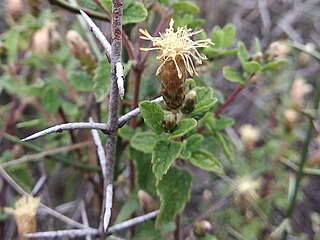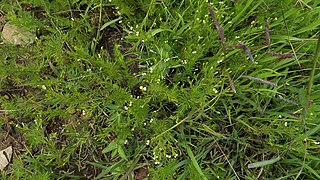
Brickellia is a North American genus of about 100 to 110 species of plants in the family Asteraceae, known commonly as brickellbushes. They are found in Canada, the United States, Mexico, and Central America. Many species are native to the American southwest, especially Texas. Brickellia is among the more basal lineages of the Eupatorieae and should not be assigned to a subtribe pending further research.
Isocarpha (pearlhead) is a genus of flowering plants in the family Asteraceae. They are native to Mexico, Central America, the West Indies, and northern South America, with the range of one species extending north into the United States.
Asanthus is a small genus of flowering plants in the family Asteraceae, found only in northern Mexico and the southwestern United States.

Steviopsis is a genus of Mexican plants in the tribe Eupatorieae within the family Asteraceae.

Brickellia veronicifolia is a North American species of plants in the family Asteraceae. It is widespread across much of Mexico, from Chihuahua to Oaxaca. In the United States, it very rare, found only in the Chisos Mountains inside Big Bend National Park in Texas, and also in Otero County in New Mexico.

Brickellia atractyloides is a North American species of flowering plant in the family Asteraceae known by the common name spearleaf brickellbush. It is native to the desert regions of the southwestern United States and northwestern Mexico.

Brickellia hastata is a North American species of shrubs in the family Asteraceae. It is found only in the state of Baja California Sur in western Mexico.
Brickellia parvula, the Mt. Davis brickellbush, is a North American species of flowering plants in the family Asteraceae. It is native to northeastern and north-central Mexico (Chihuahua) and the southwestern United States.
Brickellia rusbyi, the stinking brickellbush, is a North American species of flowering plants in the family Asteraceae. It is native to northern Mexico and the southwestern United States.

Brickellia coulteri, or Coulter's brickellbush, is a North American species of flowering plants in the family Asteraceae. It is native to Mexico and the southwestern United States.
Brickellia peninsularis is a Mexican species of flowering plants in the family Asteraceae. It is native to western Mexico in the states of Baja California, Baja California Sur, and Colima.
Brickellia rhomboidea is a Mexican species of flowering plants in the family Asteraceae. It is native to the state of Sonora in northwestern Mexico, found along the shores of the Gulf of California including on offshore islands.
Brickellia kellermanii is a Mesoamerican species of flowering plants in the family Asteraceae. It is native to Central America and southern Mexico (Chiapas).
Brickellia glandulosa is a Mesoamerican species of flowering plants in the family Asteraceae. It is widespread from San Luis Potosí south to Nicaragua.
Brickellia megaphylla is a Mexican species of flowering plants in the family Asteraceae. It is native to the state of Baja California Sur in western Mexico near the community of Loreto.
Brickellia diffusa is a Latin American species of flowering plants in the family Asteraceae. It is widespread across much of South America, Central America, Mexico, Galápagos, and the West Indies. Its distribution stretches from Sonora and Tamaulipas in northern Mexico to Jujuy in northern Argentina.
Brickellia argyrolepis is a Mesoamerican species of flowering plants in the family Asteraceae. It is native to Central America and to southern Mexico.
Brickellia tomentella is a Mesoamerican species of flowering plants in the family Asteraceae. It is native to Central America and to southern Mexico.
Carminatia tenuiflora (plumeweed) is a species of annual plants in the family Asteraceae. It is native primarily to Mexico, but also the southwestern United States and Central America.

Tagetes filifolia is a New World species of marigolds in the family Asteraceae. It is widespread across much of Latin America from northern Mexico to Argentina. Common name is Irish lace despite the fact that the plant does not grow in Ireland.






